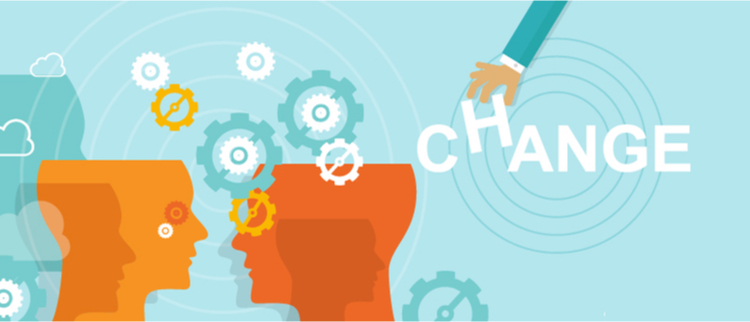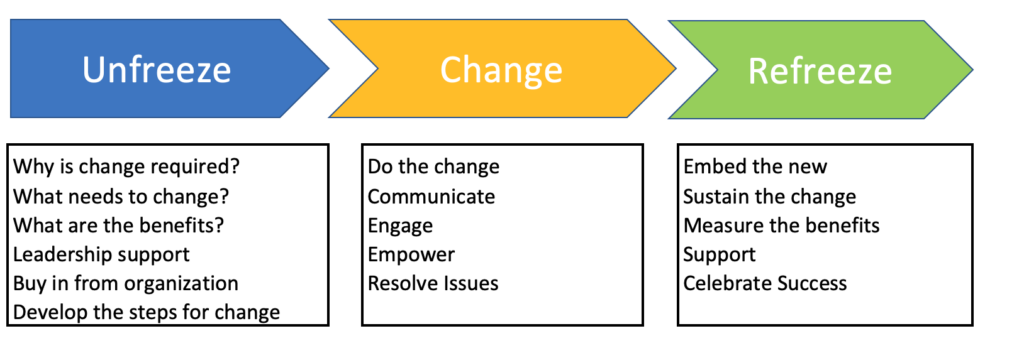
Effective change management is a cornerstone of most successful organizations. But why is change important?
Change is directly responsible for things like:
- An organization’s ability to keep up with its competitors,
- Its ability to remain efficient,
- How it takes advantage of innovation
- Compliance with emerging legislation.
So if change is so crucial – how do organizations actually “do” change?
Kurt Lewin’s model for understanding and deploying organizational change, often referred to as Unfreeze – Change – Refreeze, provides an understanding of how successful change functions, guiding an organization towards success.
In today’s article on Kurt Lewin’s Change Theory, we’ll be looking at
- What is Kurt Lewin change Theory
- Who is Kurt Lewin
- Key concepts of Change Theory
- What is the significance of Kurt Lewin Change Theory
- Benefits of Change Theory
- Criticisms of Change Theory
Let’s get started.
What is Kurt Lewin Change Theory
Lewin’s Change theory is a three-stage process that describes organizational change through the analogy of ice in that you can:
- Unfreeze it
- Create a perception that change is required
- Change it
- Move to a new, desired level of behavior/organization.
- Refreeze it
- Solidify and sustain the change.

At its most basic, a business’s chances of managing successful change depend on its change management process and how well those within the confines of the process understand them.
A key principle is that by following a method, we have a greater chance of success when deploying change than following no method at all.
Who is Kurt Lewin
With extensive research and published material on Leadership and Leadership Styles, social psychologist Kurt Lewin’s (1890-1947) continues to significantly influence business practices worldwide.
His work included:
- Leadership Styles
- Decision Making
- Force Field Theory
- Change Management methods
Key concepts of Lewin’s Change Theory
As we mentioned above, Lewin’s Change theory features three states which describe how an organization transitions through the change process. Let’s cover these in a little more detail.

1/ Unfreeze
Stage one centers around the concept of preparation for change.
This typically involves:
- Determining why change is required (this will require a view of what could happen if no change occurs).
- Determining what needs to change (this may require a deep understanding of practices and processes)
- Determining the benefits of change (both for the organization and individuals within it).
- Fostering and obtaining support from leadership
- Obtaining acceptance from within the organization
- Developing messaging
- Communicating
- Capturing concerns
- Reviewing risk
- Devising the steps to be taken to implement change
Uncertainty and unease within the workforce can provide a substantial hurdle.
As a result, the first stage of change is often the most challenging, with stage one commonly evoking a strong emotional response within the workforce.
You do not achieve this purely through the voice and sentiment of one individual but usually need to have a visible goal, supported by leadership where you can demonstrate (statistically and emotionally) what would happen if the change is not adopted.
2/ Change
The first thing to understand is that the move from unfreeze to change does not happen immediately. Time will be required for people to, at first comprehend, and then later embrace the change for them to participate in it.
This stage usually involves elements such as:
- Executing or Doing the change (following a plan)
- Communication
- Engagement of staff
- Explain what the change means and how they will be affected
- Drive involvement with the process
- Empowering people within the organization
- Dealing with problems
- This is likely to deal with pockets of resistance within the organization
Stage two helps staff resolve any uncertainty from stage one with direct engagement with the process.
Key to this stage is gaining some palpable victories which help obtain and maintain support as your change project matures.
The three key enablers of this phase are
- Time – people will need time to both adapt and align with the goal
- Connection – people will continually need to be connected directly with the change and its benefits.
- Communication. – the central messages around the need for change, the benefits for, and the consequences of failure will need to be continually reinforced.
3/ Refreeze
Stage three describes:
- Embedding the ‘new’ within the organization’s culture
- Sustaining the change
- Finalizing documentation and supporting artifacts
- monitor and support engagement
- Removing risk / Dealing with issues
- Measuring the benefits
- Adopting and monitoring key performance indicators
- Support / Training/ Education
- Celebrate success
Once the change is deployed, and the organization has adopted the ‘new,’ the organization can then refreeze.
This phase drives stability and consistency and requires universal adoption where ‘new’ is the norm with the change embedded in everyday life.
What is the significance of Kurt Lewin Change Theory?
Kurt Lewin’s approach is a significant contribution to how organizations adopt change. It provides a stage by stage methodology that can be adopted by organizations across different industries.
It is a widely adopted methodology and puts forward a simple but powerful method for comprehending change.
Benefits of Kurt Lewin’s Change Theory
There are numerous benefits associated with the theory that include:
- It is a simple three-stage method
- It’s easy to use
- It encourages lasting change
- It offers a gradual approach
- Helps an organization visualize what needs to be done
Criticisms of Lewin’s Change Theory
Of course, how sharp a business is at managing change leverages on various factors from the resources it has at its disposal, the depth and criticality of the change even to simply the industry the business operates within. As ever, one theory may not cover everything, and some criticisms leveled at Lewin’s theory include:
- It is overly simplistic.
- It promotes the expectation of a linear experience, i.e., input leads to output, which derives the outcome. This is not always the case.
- It doesn’t promote agility.
- It doesn’t account for learning. Most organizations will have limits of knowledge and will require to generate a greater understanding of what works and how different aspects of change affect each other.
Summary
Change can be a monumental struggle for many organizations. Change isn’t as outrightly successful as you might like to believe (Significant numbers of change projects fail outright).
As this is the case, how do you interpret widely adopted methodologies? Are they wrong? Are they not utilized correctly?
Clearly, there is much debate to be had.
If your organization is undergoing a change program or perhaps you’ve participated in one previously, we’d love to hear your experiences. What methodology did you adopt? How did things work out?
As ever, you can connect with us on Twitter or use the comments section below.
This article is part of our Management & Leadership guide.